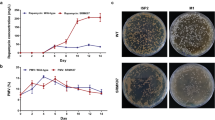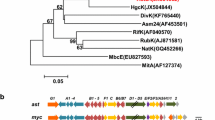Abstract
Sequence analysis of the rapamycin biosynthetic gene cluster in Streptomyces rapamycinicus ATCC 29253 identified several putative regulatory genes. The deduced product of rapY, rapR, and rapS showed high sequence similarity to the TetR family transcription regulators, response regulators and histidine kinases of two-component systems, respectively. Overexpression of each of the three genes resulted in a significant reduction in rapamycin production, while in-frame deletion of rapS and rapY from the S. rapamycinicus chromosome improved the levels of rapamycin production by approximately 4.6-fold (33.9 mg l−1) and 3.7-fold (26.7 mg l−1), respectively, compared to that of the wild-type strain. Gene expression analysis by semi-quantitative reverse transcription-PCR (RT-PCR) in the wild-type and mutant strains indicated that most of the rapamycin biosynthetic genes are regulated negatively by rapS (probably through its partner response regulator RapR) and rapY. Interestingly, RapS negatively regulates the expression of the rapY gene, and in turn, rapX encoding an ABC-transporter is negatively controlled by RapY. Finally, overexpression of rapX in the rapS deletion mutant resulted in a 6.7-fold (49 mg l−1) increase in rapamycin production compared to that of wild-type strain. These results demonstrate the role of RapS/R and RapY as negative regulators of rapamycin biosynthesis and provide valuable information to both understand the complex regulatory mechanism in S. rapamycinicus and exploit the regulatory genes to increase the level of rapamycin production in industrial strains.



Similar content being viewed by others
References
Andexer JN, Kendrew SG, Nur-e-Alam M, Lazos O, Foster TA, Zimmermann AS, Warneck TD, Suthar D, Coates NJ, Koehn FE, Skotnicki JS, Carter GT, Gregory MA, Martin CJ, Moss SJ, Leadlay PF, Wilkinson B (2011) Biosynthesis of the immunosuppressants FK506, FK520, and rapamycin involves a previously undescribed family of enzymes acting on chrorismate. Proc Natl Acad Sci USA 108:4776–4781
Baumeister R, Muller G, Hecht B, Hillen W (1992) Functional roles of amino acid residues involved in forming the alpha-helix-turn-alpha-helix operator DNA binding motif of Tet repressor from Tn10. Proteins 14:168–177
Bierman M, Logan R, O’Brien K, Seno ET, Rao RN, Schoner BE (1992) Plasmid cloning vectors for the conjugal transfer of DNA from Escherichia coli to Streptomyces spp. Gene 116:43–49
Calne RY, Collier DS, Lim S, Pollard SG, Samaan A, White DJ, Thiru S (1989) Rapamycin for immunosuppression in organ allografting. Lancet 334(8656):227
Chang HM, Chen MY, Shieh YT, Bibb MJ, Chen CW (1996) The cutRS signal transduction system of Streptomyces lividans represses the biosynthesis of the polyketide antibiotic actinorhodin. Mol Microbiol 21:1075–1085
Cundliffe E (2008) Control of tylosin biosynthesis in Streptomyces fradiae. J Microbiol Biotechnol 18:1485–1491
Delany I, Sheehan MM, Fenton A, Bardin S, Aarons S, O’Gara F (2000) Regulation of production of the antifungal metabolite 2,4-diacetylphloroglucinol in Pseudomonas fluorescens F113: genetic analysis of phlF as a transcriptional repressor. Microbiology 146:537–543
Douros J, Suffness M (1981) New antitumor substances of natural origin. Cancer Treat Rev 8:63–87
Gatto GJ Jr, Boyne MT 2nd, Kelleher NL, Walsh CT (2006) Biosynthesis of pipecolic acid by RapL, a lysine cyclodeaminase encoded in the rapamycin gene cluster. J Am Chem Soc 128:3838–3847
Gregory MA, Gaisser S, Lill RE, Hong H, Sheridan RM, Wilkinson B, Petkovic H, Weston AJ, Carletti I, Lee HL, Staunton J, Leadlay PF (2004) Isolation and characterization of prerapamycin, the first macrocyclic intermediate in the biosynthesis of the immunosuppressant rapamycin by S. hygroscopicus. Angew Chem Int Ed 43:2551–2553
Gregory MA, Hong H, Lill RE, Gaisser S, Petkovic H, Low L, Sheehan LS, Carletti I, Ready SJ, Ward MJ, Kaja AL, Weston AJ, Challis IR, Leadlay PF, Martin CJ, Wilkinson B, Sheridan RM (2006) Rapamycin biosynthesis: elucidation of gene product function. Org Biomol Chem 4:3565–3568
Guilfoile PG, Hutchinson CR (1992) Sequence and transcriptional analysis of the Streptomyces glaucescens tcmAR tetracenomycin C resistance and repressor gene loci. J Bacteriol 174:3651–3658
Harrison DE, Strong R, Sharp ZD, Nelson JF, Astle CM, Flurkey K, Nadon NL, Wilkinson JE, Frenkel K, Carter CS, Pahor M, Javors MA, Fernandez E, Miller RA (2009) Rapamycin fed late in life extends lifespan in genetically heterogeneous mice. Nature 460:392–395
Hillen W, Berens C (1994) Mechanisms underlying expression of Tn10 encoded tetracycline resistance. Annu Rev Microbiol 48:345–369
Horinouchi S (2002) A microbial hormone, A-factor, as a master switch for morphological differentiation and secondary metabolism in Streptomyces griseus. Front Biosci 7:2045–2057
Horn F, Schroeckh V, Netzker T, Guthke R, Brakhage AA, Linde J (2014) Draft genome sequence of Streptomyces iranensis. Genome Announc 2(4). pii: e00616–14
Hu H, Huang H, Lu X, Zhu B (2013) Comparative analysis of rapamycin biosynthesis clusters between Streptomyces hygroscopicus ATCC29253 and Actinoplanes sp. N902–109. GenBank accession no. GQ166664.2
Jung WS, Yoo YJ, Park JW, Park SR, Han AR, Ban YH, Kim EJ, Kim E, Yoon YJ (2011) A combined approach of classical mutagenesis and rational metabolic engineering improves rapamycin biosynthesis and provides insights into methylmalonyl-CoA precursor supply pathway in Streptomyces hygroscopicus ATCC 29253. Appl Microbiol Biotechnol 91:1389–1397
Kahan BD, Gibbons S, Tejpal N, Stepkowski SM, Chou TC (1991) Synergistic interactions of cyclosporine and rapamycin to inhibit immune performances of normal human peripheral blood lymphocytes in vitro. Transplantation 51:232–239
Khaw LE, Böhm GA, Metcalfe S, Staunton J, Leadlay PF (1998) Mutational biosynthesis of novel rapamycins by a strain of Streptomyces hygroscopicus NRRL 5491 disrupted in rapL, encoding a putative lysine cyclodeaminase. J Bacteriol 180:809–814
Kieser T, Bibb MJ, Buttner MJ, Chater KF, Hoopwood DA (2000) Practical Streptomyces genetics. John Innes Centre, Norwich
König A, Schwecke T, Molnar I, Böhm GA, Lowden PA, Staunton J, Leadlay PF (1997) The pipecolate-incorporating enzyme for the biosynthesis of the immunosuppressant rapamycin—nucleotide sequence analysis, disruption and heterologous expression of rapP from Streptomyces hygroscopicus. Eur J Biochem 247:526–534
Kumar Y, Goodfellow M (2008) Five new members of the Streptomyces violaceusniger 16S rRNA gene clade: Streptomyces castelarensis sp. nov., comb. nov., Streptomyces himastatinicus sp. nov., Streptomyces mordarskii sp. nov., Streptomyces rapamycinicus sp. nov. and Streptomyces ruanii sp. nov. Int J Syst Evol Microbiol 58:1369–1378
Kuščer E, Coates N, Challis I, Gregory M, Wilkinson B, Sheridan R, Petković H (2007) Roles of rapH and rapG in positive regulation of rapamycin biosynthesis in Streptomyces hygroscopicus. J Bacteriol 189:4756–4763
Ma D, Alberti M, Lynch C, Nikaido H, Hearst JE (1996) The local repressor AcrR plays a modulating role in the regulation of acrAB genes of Escherichia coli by global stress signals. Mol Microbiol 19:101–112
McKenzie NL, Nodwell JR (2007) Phosphorylated AbsA2 negatively regulates antibiotic production in Streptomyces coelicolor through interactions with pathway-specific regulatory gene promoters. J Bacteriol 189:5284–5292
Méndez C, Salas JA (2001) The role of ABC transporters in antibiotic-producing organisms: drug secretion and resistance mechanisms. Res Microbiol 152:341–350
Mo S, Yoo YJ, Ban YH, Lee SK, Kim E, Suh JW, Yoon YJ (2012) Roles of fkbN in positive regulation and tcs7 in negative regulation of FK506 biosynthesis in Streptomyces sp. strain KCTC 11604BP. Appl Environ Microbiol 78(7):2249–2255
Mo S, Kim DH, Lee JH, Park JW, Basnet DB, Ban YH, Yoo YJ, Chen SW, Park SR, Choi EA, Kim E, ** YY, Lee SK, Park JY, Liu Y, Lee MO, Lee KS, Kim SJ, Kim D, Park BC, Lee SG, Kwon HJ, Suh JW, Moore BS, Lim SK, Yoon YJ (2011) Biosynthesis of the allylmalonyl-CoA extender unit for the FK506 polyketide synthase proceeds through a dedicated polyketide synthase and facilitates the mutasynthesis of analogues. J Am Chem Soc 133:976–985
Molnár I, Aparicio JF, Haydock SF, Khaw LE, Schwecke T, König A, Staunton J, Leadlay PF (1996) Organisation of the biosynthetic gene cluster for rapamycin in Streptomyces hygroscopicus: analysis of genes flanking the polyketide synthase. Gene 169:1–7
Olano C, Lombó F, Méndez C, Salas JA (2008) Improving production of bioactive secondary metabolites in actinomycetes by metabolic engineering. Metab Eng 10:281–292
Otten SL, Ferguson J, Hutchinson CR (1995) Regulation of daunorubicin production in Streptomyces peucetius by the dnrR2 locus. J Bacteriol 177:1216–1224
Otten SL, Olano C, Hutchinson CR (2000) The dnrO gene encodes a DNA-binding protein that regulates daunorubicin production in Streptomyces peucetius by controlling expression of the dnrN pseudo response regulator gene. Microbiology 146:1457–1468
Park SR, Yoo YJ, Ban YH, Yoon YJ (2010) Biosynthesis of rapamycin and its regulation: past achievements and recent progress. J Antibiot (Tokyo) 63:434–441
Qiu J, Zhuo Y, Zhu D, Zhou X, Zhang L, Bai L, Deng Z (2011) Overexpression of the ABC transporter AvtAB increases avermectin production in Streptomyces avermitilis. Appl Microbiol Biotechnol 92:337–345
Ramos JL, Martínez-Bueno M, Molina-Henares AJ, Terán W, Watanabe K, Zhang X, Gallegos MT, Brennan R, Tobes R (2005) The TetR family of transcriptional repressors. Microbiol Mol Biol Rev 69:326–356
Rozen S, Skaletsky H (2000) Primer3 on the WWW for general users and for biologist programmers. Methods Mol Biol 132:365–386
Sehgal SN, Baker H, Vézina C (1975) Rapamycin (AY-22,989), a new antifungal antibiotic. II. Fermentation, isolation and characterization. J Antibiot (Tokyo) 28:727–732
Schmitt-John T, Engels JE (1992) Promoter constructions for efficient secretion expression in Streptomyces lividans. Appl Microbiol Biotechnol 36:493–498
Schwecke T, Aparicio JF, Molnár I, König A, Khaw LE, Haydock SF, Oliynyk M, Caffrey P, Cortés J, Lester JB, Böhm GA, Staunton J, Leadlay PF (1995) The biosynthetic gene cluster for the polyketide immunosuppressant rapamycin. Proc Natl Acad Sci USA 92:7839–7843
Sheeler NL, MacMillan SV, Nodwell JR (2005) Biochemical activities of the absA two-component system of Streptomyces coelicolor. J Bacteriol 187:687–696
Shu D, Chen L, Wang W, Yu Z, Ren C, Zhang W, Yang S, Lu Y, Jiang W (2009) afsQ1-Q2-sigQ is a pleiotropic but conditionally required signal transduction system for both secondary metabolism and morphological development in Streptomyces coelicolor. Appl Microbiol Biotechnol 81:1149–1160
Steiner JP, Connolly MA, Valentine HL, Hamilton GS, Dawson TM, Hester L, Snyder SH (1997) Neurotrophic actions of nonimmunosuppressive analogues of immunosuppressive drugs FK506, rapamycin and cyclosporin A. Nat Med 3:421–428
Stock AM, Robinson VL, Goudreau PN (2000) Two-component signal transduction. Annu Rev Biochem 69:183–215
Stratigopoulos G, Cundliffe E (2002) Inactivation of a transcriptional repressor during empirical improvement of the tylosin producer, Streptomyces fradiae. J Ind Microbiol Biotechnol 28:219–224
Stutzman-Engwall KJ, Otten SL, Hutchinson CR (1992) Regulation of secondary metabolism in Streptomyces spp. and overproduction of daunorubicin in Streptomyces peucetius. J Bacteriol 174:144–154
Ullán RV, Liu G, Casqueiro J, Gutiérrez S, Bañuelos O, Martín JF (2002) The cefT gene of Acremonium chrysogenum C10 encodes a putative multidrug efflux pump protein that significantly increases cephalosporin C production. Mol Genet Genomics 267:673–683
Yu Z, Zhu H, Dang F, Zhang W, Qin Z, Yang S, Tan H, Lu Y, Jiang W (2012) Differential regulation of antibiotic biosynthesis by DraR-K, a novel two-component system in Streptomyces coelicolor. Mol Microbiol 85:535–556
Acknowledgments
This work was supported by the Basic Science Research Program through the National Research Foundation of Korea (NRF) funded by the Ministry of Science, ICT and Future Planning (MISP) (2013R1A2A1A01014230), the Intelligent Synthetic Biology Center of the Global Frontier Project funded by MISP (20110031961), CKD Bio Advanced Technology Center funded by the Ministry of Trade, Industry and Energy, and Advanced Production Technology Development Program, Ministry of Agriculture, Food and Rural Affairs, Republic of Korea, and Ewha Womans University (1201349190011).
Author information
Authors and Affiliations
Corresponding author
Electronic supplementary material
Below is the link to the electronic supplementary material.
Rights and permissions
About this article
Cite this article
Yoo, Y.J., Hwang, Jy., Shin, Hl. et al. Characterization of negative regulatory genes for the biosynthesis of rapamycin in Streptomyces rapamycinicus and its application for improved production. J Ind Microbiol Biotechnol 42, 125–135 (2015). https://doi.org/10.1007/s10295-014-1546-9
Received:
Accepted:
Published:
Issue Date:
DOI: https://doi.org/10.1007/s10295-014-1546-9




